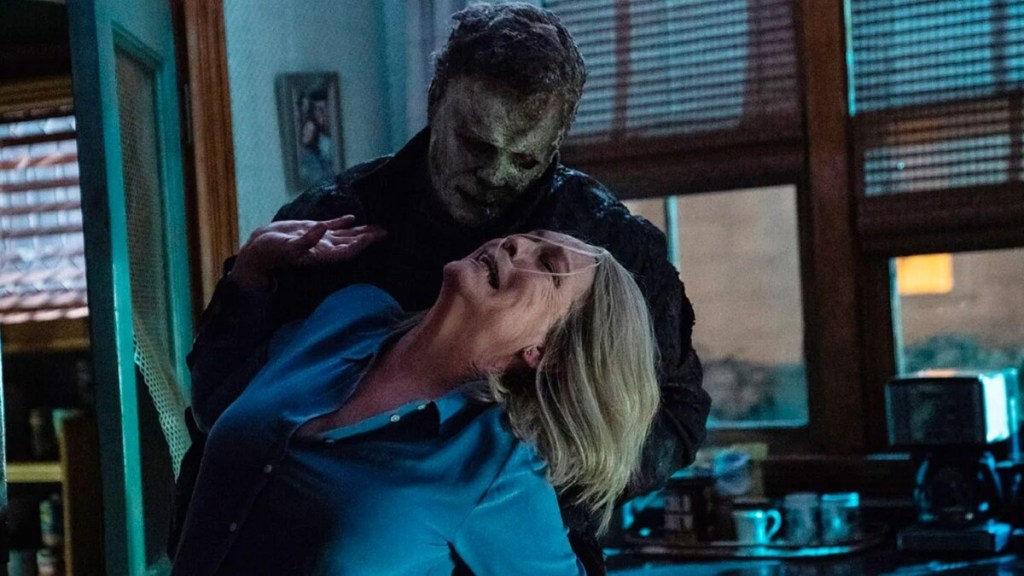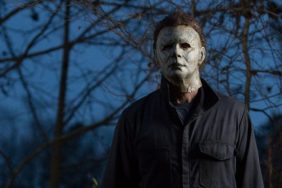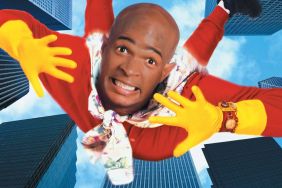A year has passed since David Gordon Green completed his Halloween trilogy, which began with 2018’s Halloween and culminated with 2021’s Halloween Kills and 2022’s Halloween Ends. The last time I watched the series was last October, and I was eager to give it another go to see if my opinion might have changed after the long hiatus.
Does this latest iteration of Halloween still hold up?
The Plot
Serving as a proper sequel to John Carpenter’s original Halloween, Green’s Halloween picks up some 40 years later and finds Laurie Strode (Jamie Lee Curtis) neglecting life to prepare for a final brawl with Michael Myers. Naturally, things go to pot. A plethora of people die, a third-act confrontation ensues, and Michael supposedly burns to death in a house fire started by Laurie and her daughter and granddaughter.
A few years later, Universal pushed for not one but two sequels — because money talks. As it turns out, Michael didn’t die at the end of Halloween 2018; instead, he emerged from the fire and killed at least 1,122 people en route to his home. (Okay — maybe that’s a generous estimate.)
Laurie spends the movie in a hospital bed, where she watches the residents of Haddonfield fall into anarchy due to Michael’s evil influence. Michael kills Laurie’s daughter vanishes for a few years before re-emerging to after Corey Cunningham (Rohan Campbell) reawakens his bloodlust. Michael’s stopped killing by this point, but Corey’s own violent tendencies bring him back into the fold in Halloween Ends. After more tomfoolery, Michael finally meets a grisly end via a grinding machine that chops his body to pieces. This puts the Boogeyman to rest for the time being.
Critical Reception
Green’s Halloween received generally favorable reviews compared to previous entries. Halloween 2018 achieved a 79% approval rating on Rotten Tomatoes, while Kills and Ends dipped to 39% and 40%, respectively. Audiences were more varied, with only 72% awarding the first entry a positive review, followed by a surprising 66% for Kills and 57% for Ends.
Box Office
As is customary for a horror franchise, the Halloween trilogy saw an enormous decline in box office receipts. Of course, few expected Halloween 2018 to rack up $255M worldwide, making it the most successful entry in the long-running series. COVID delays pushed Kills back a year, meaning the sequel didn’t hit theaters for three years.
That hiatus impacted its box office, as it only achieved $130M worldwide. By the time Ends rolled around in October of 2022, audiences had moved on, resulting in a meager $105M worldwide total. Of course, it doesn’t help that the sequels also premiered on Peacock. Per Samba TV, 1.7M households viewed Kills while 920K viewed Ends. Either way you slice it, the trilogy peaked early and ran out of steam quickly.
Initial Reaction
Like a huge chunk of the world, I mostly enjoyed Halloween 2018. Following the meta-approach taken by Star Wars, Ghostbusters, Jurassic World, and other franchises, this new entry pays homage to the original. It sticks closely to the formula and relies too heavily on fan nostalgia, but Green gives audiences what they paid for — a few good scares and a lot of blood. It was a fun theater experience, resulting in perhaps the best iteration of Michael Myers to date, and tied a nice bow around the 40-year franchise.
Halloween Kills muddies the waters and needlessly expands the story, rendering much of Halloween 2018 moot. The film lacked focus and purpose and contradicted its predecessor. Is Michael Myers an actual Boogeyman or just another dude in a mask? He appeared vulnerable in 2018, particularly during his violent battle with Laurie. In the follow-up, he’s more in line with the iteration that appeared in all of those goofy direct-to-DVD sequels in the late 80s/early 90s — he’s an unkillable machine, possessing super strength and teleportation powers, an enormous leap if you’re watching the films in chronological order.
Still, Kills doesn’t wholly stink, if only because of Michael’s shocking savagery. The man unleashes an unholy wave of death upon Haddonfield and reestablishes himself as the de facto scream king. Unfortunately, for every gnarly set piece — notably the Michael vs. the Mob sequence — there are two or three Big John/Little John bits that needlessly diminish Kills’ overall impact.
Finally, I was impressed with Halloween Ends on my first watch. Admittedly, I viewed Green’s third chapter on my TV at home as Kills slaughtered the goodwill established by Green in 2018. To my surprise and amusement, Ends goes in a unique new direction, casting Laurie aside in favor of an all-new character, Corey Cunningham, at least until the third act.
Of all three films, Ends is the only one that feels like a John Carpenter production down to the synth-heavy score. Here, Green goes for something different, diverging from his safe space and traversing into the psychological terror Rob Zombie tackled in his iterations. I applaud the effort and felt compelled by Corey’s strange transformation from a downtrodden victim to a full-on serial killer. It was fascinating to watch and left me strangely excited for more.
On Second Watch — Halloween (2018)
I watched Halloween 2018 several times, mostly in preparation for the sequels. Still, it had been over a year since my last viewing, and I was eager to jump back into Michael Myers’ pool of death. Eh, only five years removed from its debut, I was surprised at how dated the picture has already become. Green’s direction is solid enough to produce a few good scares, but he struggles to maintain a consistent tone. Halloween 2018 veers awkwardly from horror to comedy, making it difficult to care about anything happening on screen. Should we care about a hapless babysitter when the kid she’s watching spouts funny dialogue that undermines the scene’s intensity?
This new chapter also succumbs to the modern trend of rendering its male characters as clowns to prop up the female protagonists further. Literally every male character in this film is a moron. From Allyson’s boyfriend Cameron (Dylan Arnold), who wanders around in a dress for much of the picture, to her father Ray (Toby Huss), whose only contribution to the narrative involves dropping peanut butter on his penis, the men are dumbasses. Funny shit, right?
When Ray dies, neither Allyson nor his wife Karen (Judy Greer) seem to care. Side characters like Oscar (Drew Scheid) and Dave (Miles Robbins) contribute little to the narrative, and even Michael makes stupid decisions whenever the plot requires him to do so. Dumb characters are a slasher movie trope. In Halloween 2018, the stupidity is more egregious and distracting than playfully ironic.
But why cling to an outdated trope when so many other possibilities exist? I remember when Universal announced Halloween 2018 all those years ago. My initial thought was David Gordon Green, the man behind The Pineapple Express, came up with a new story to tell. Otherwise, why would he tackle the property? Halloween movies will continually hit movie screens until the end of time, but this was an opportunity to give the franchise a fresh coat of paint, ala Scream in 1996. Instead, Halloween 2018 lazily follows the model established by Carpenter in 1978. While fans may go gaga on opening weekend at all the callbacks and homages to the original feature, that same fanservice drags the film’s rewatchability factor down to zero. I’d rather watch Halloween (1978) than a cheap knockoff.
Laurie Strode is also a problem. I like Jamie Lee Curtis, for the most part, but bringing her back for another round with Michael was a mistake. Their confrontation only illustrates the production’s lack of creative spark, mainly since we already saw this song and dance in 1998’s Halloween H20. Moreover, since Laurie is no longer related to Michael, her struggle feels less personal and more self-inflicted. He’s not after her or her family. And if she feels unsafe, why continue to live in Haddenfield?
Like Sarah Connor in the last Terminator flick, Laurie hasn’t progressed much since 1978. Listen, 40 years is a long time to harbor a grudge for a man who killed (checks notes) five people one Halloween night.
Finally, Halloween 2018 doesn’t propel the franchise forward. The entire production feels like a silly piece of fan fiction that never justifies its existence. At least all those sequels with Donald Pleasance had the good sense to expand the lore in unusual (and dopey) ways. The results were almost always ridiculous, but they often moved the franchise in exciting directions.
On Second Watch — Halloween Kills and Ends
My second viewing of Halloween Kills left me more frustrated than anything. Here is a sequel bursting with thrilling ideas but unable to transform them into anything worthwhile. I love the concept of former Michael Myers victims banding together to hunt and take him down. That should have been the movie.
Instead, we get a clunky narrative about a town falling into anarchy when a serial killer who murdered (checks notes) five people 40 years ago escapes from prison and … heads back to his house.
We meet a handful of protagonists led by Anthony Michael Hall’s Tommy Doyle and basically watch them die, but only after they proclaim, “Evil dies tonight” a dozen or so times. By the time Michael kills a woman by using a car door to make her blow her own head off with a gun, I realized Halloween Kills wasn’t interested in anything beyond simple thrills.
To that end, the sequel sporadically delivers. As stated, Michael goes on a wicked murder spree that ranges from terrifying to comically over-the-top. Had the film designed him as an actual human with a knack for survival instead of an indestructible force of nature, we might have cared more about the endless slaughter onscreen. As is, Halloween Kills offers simple pleasures but feels as though it were hastily written to bridge the gap between Halloween and Halloween Ends. Honestly, you could jump straight to the third chapter without missing a beat. Though, you’d miss out on some genuinely remarkable kills.
Speaking of which, Halloween Ends is the best of the bunch. No, really. The third entry stands out thanks to its eerie atmosphere, devotion to character, and complexity. Here, Green finally uncovers a story he’s eager to tell and figures out how to steer the Halloween concept in a more stimulating direction. Oh sure, he still delivers the obligatory stalker sequences and gruesome violence fans desire. But the story delves into the psychology behind the madness, and explores the evil lurking behind that creepy William Shatner mask.
Ends isn’t perfect, but I’ll take an ambitious, flawed production over a cookie-cutter, built-by-committee approach any day.
On the negative side, Green should have introduced Corey in the previous films. Or, better yet, instead of Corey, make Allyson the focus. The entire trilogy could have explored how evil grows inside Allyson due to her run-ins with Michael. He destroyed her family, murdered her parents, and left her with a half-crazed grandmother. Now, she’s a target for bullies and superstitious townsfolk, who push her to the brink until she topples over the edge and morphs into the next Michael Myers.
Maybe that was Green’s initial pitch and why he was drawn to the series. Or maybe not.
As is, Corey’s story is engrossing but rushed. After a killer opening (literally) that stands as one of the best in the franchise, we see the poor guy dealing with the repercussions of a tragic incident and questioning the evil lurking within his person. He falls for Allyson, and the pair enjoy a wild night of partying and plan to leave town together, convinced that Haddonfield is cursed. Corey bumps into an old and decrepit Michael, now clinging to life in a sewer — his evil infecting Haddonfield from within — and becomes his apprentice.
Several questions remain. At the end of Kills, Michael knifes Laurie’s daughter and vanishes, prompting Laurie to cast aside her rugged ways in favor of … a normal domesticated lifestyle. It’s baffling. If anything, Laurie should be more bitter and angry that she wasted her life trying to protect her family and ultimately failed. She should want revenge now more than ever. Also, why is no one looking for Michael? His entire purpose in Kills was to go home. Yet for whatever reason, he disappeared and decided to retire in a sewer. Why?
My answer: perhaps David Gordon Green wanted Halloween Ends to be his follow-up to Halloween 2018 but was coerced into producing a middle chapter to appease studio heads who worried the lack of Michael Myers would turn fans away. It makes sense.
Watching this new series of films with fresh eyes further cemented my belief in Green’s original intentions. I appreciated Halloween Ends on my second viewing and believe it ranks high on the list of Halloween chapters, even if it doesn’t fully rise to its potential. At the very least, it tries something new and stands out amongst the other two unremarkable films in the trilogy.










